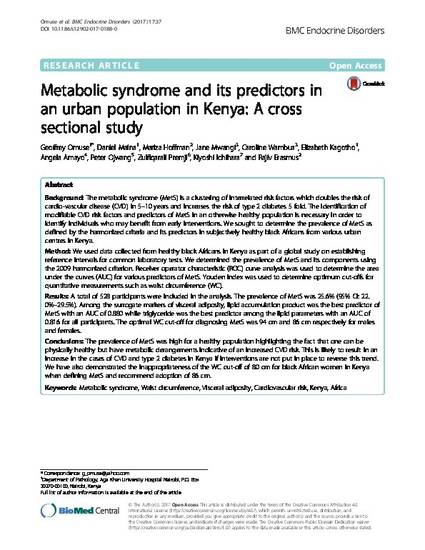
Background: The metabolic syndrome (MetS) is a clustering of interrelated risk factors which doubles the risk of cardio-vascular disease (CVD) in 5–10 years and increases the risk of type 2 diabetes 5 fold. The identification of modifiable CVD risk factors and predictors of MetS in an otherwise healthy population is necessary in order to identify individuals who may benefit from early interventions. We sought to determine the prevalence of MetS as defined by the harmonized criteria and its predictors in subjectively healthy black Africans from various urban centres in Kenya.
Method: We used data collected from healthy black Africans in Kenya as part of a global study on establishing reference intervals for common laboratory tests. We determined the prevalence of MetS and its components using the 2009 harmonized criterion. Receiver operator characteristic (ROC) curve analysis was used to determine the area under the curves (AUC) for various predictors of MetS. Youden index was used to determine optimum cut-offs for quantitative measurements such as waist circumference (WC).
Results: A total of 528 participants were included in the analysis. The prevalence of MetS was 25.6% (95% CI: 22. 0%–29.5%). Among the surrogate markers of visceral adiposity, lipid accumulation product was the best predictor of MetS with an AUC of 0.880 while triglyceride was the best predictor among the lipid parameters with an AUC of 0.816 for all participants. The optimal WC cut-off for diagnosing MetS was 94 cm and 86 cm respectively for males and females.
Conclusions: The prevalence of MetS was high for a healthy population highlighting the fact that one can be physically healthy but have metabolic derangements indicative of an increased CVD risk. This is likely to result in an increase in the cases of CVD and type 2 diabetes in Kenya if interventions are not put in place to reverse this trend. We have also demonstrated the inappropriateness of the WC cut-off of 80 cm for black African women in Kenya when defining MetS and recommend adoption of 86 cm.
Available at: http://works.bepress.com/zul_premji/80/
